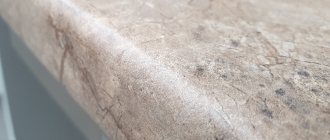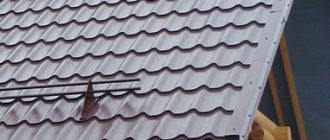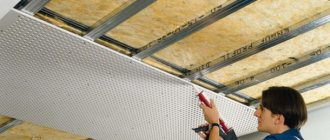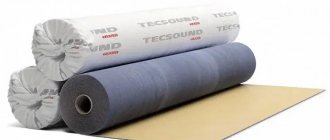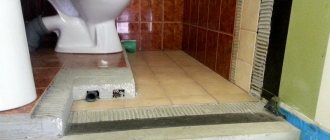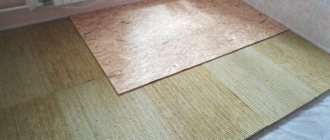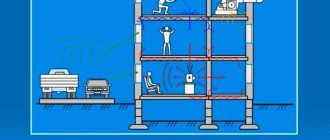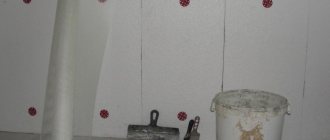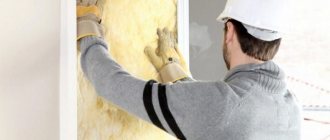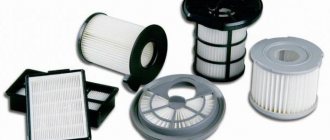Aerated concrete is a lightweight and porous material that has mediocre sound insulation. Let's first figure out where sound insulation is needed most and what types of noise there are.
Some new buildings suffer most from excess noise, in which the partition walls between apartments and rooms are too thin, and various sounds can be heard from neighbors.
Such partitions are most often made of aerated concrete, but thin low-density aerated concrete has poor sound insulation, so you need to increase the wall thickness or density.
Sound insulation of aerated concrete and brick
To stop a sound wave as much as possible, mass is needed, that is, high-density materials, for example brick, are best suited for partitions, while aerated concrete is lightweight and inferior to brick in sound insulation of wave noise. But it is worth noting that aerated concrete retains low-frequency structural noise better than brick; read about this below in the text.
Features of soundproofing ceilings
Before choosing materials that can limit the entry of noise into a room with suspended ceilings, you need to decide which sounds bother you most often.
It is no secret that there are several types of noise, and depending on its cause and strength, various soundproofing methods are implemented. Remember! Soundproofing a suspended ceiling in an apartment will not always be able to completely rid you of extraneous noise: in some cases it is necessary to provide additional protection for the floor and walls, since sounds can enter the room from all sides.
However, it is the soundproofing of the ceiling that is the most important procedure, since the maximum sounds come from neighbors living above every day. By choosing a suspended ceiling for a room, you will greatly facilitate this work, since it is this design that allows you to get rid of noise with the best efficiency
The simplicity of sound insulation in this case is ensured by the fact that in a soft or loose surface the sound is interrupted and disappears: hard structures, on the contrary, facilitate its further passage into the room. In addition, the layer of air between the base of the ceiling and the tension film itself also helps absorb noise.
Thanks to the ability to install various soundproofing materials in the interceiling space, the choice becomes unlimited, and you can find an option that suits both quality and cost.
Important! The best sound-absorbing properties are those that are porous, soft, or fiber-based, as well as those that include several different layers.
Most often, sound insulation under a suspended ceiling is created through the use of the following materials:
- mineral basalt panels (notable for their durability, as well as ease and safety of installation, do not cause negative reactions upon contact);
- polystyrene foam and polypropylene foam (easily glued to the ceiling surface and enhance sound insulation with the additional use of plaster, used for protection against sounds of moderate volume);
- mineral wool (in addition to sound insulation, it has fire-fighting properties and provides additional protection from the cold).
These and many other soundproofing materials for ceilings differ in their characteristics, but reliably protect against noise
When choosing a material for soundproofing a stretch ceiling, pay attention to the sound absorption coefficient: for example, windproof materials cope with this task worse than others
Sound insulation index of aerated concrete (airborne noise)
A little theory about noise. Sound itself can be divided into three types, each of which has its own frequency and travels through different materials in different ways.
Impact (vibration) - a blow passes through the wall, and vibrations begin in it, which create an audible sound on both sides of the wall. Vibration noise travels very far, passing through walls, floors and ceilings, since the structures are rigidly connected to each other. Such noise includes: hammering, objects falling on the floor, stomping.
Airborne noise (wave noise) is the most common and frequent type of noise, which is produced by the human voice, TV, barking dogs, etc. The sound wave spreads in all directions, part of the sound wave is reflected from the walls, part is damped, and part of the sound can pass through the wall.
Structural noise is an intermediate type of noise between shock and wave, sources are: garbage chute, pipes, elevator, ventilation system.
Is there any point in soundproofing?
Good day. I live in Leningrad.
I’ll tell you about my experience in soundproofing the ceiling. We moved into a new apartment in the seaside area. The house is panel. I heard that in houses of this type there are problems with sound insulation, but I had never encountered this before, perhaps because in the old apartment the neighbors were mostly pensioners. But in new buildings the situation is different, there are many young people, especially with children. There was just a family with a small child above us. At the renovation stage, my fears were confirmed. If it’s still okay in the morning, you can hear them walking and getting ready for work, you could put up with it. But in the evening there was some kind of hell, you could hear their child running, jumping and all this until 10 pm.
I decided to do the soundproofing first, and then the rest of the repairs. Having studied a lot of information about methods for solving this problem. I came to the conclusion that in my case it is necessary to make a suspended ceiling with vibration mounts. As a rule, such a scheme removes airborne noise (voice, TV) and impact noise (clamping, moving furniture). I was serious and, in order not to procrastinate, I began searching for materials. I settled on Maxforte slabs because of the optimal density of 60 kg/m3, decent acoustic characteristics, maximum class A for sound absorption, and the absence of various harmful binders such as phenol.
I found a team of installers on Avito. The installation process itself is quite simple. We fixed the vibration suspensions to the ceiling, assembled the frame using the Knauf system, laid the slabs and sewed them with two sheets of gypsum fiber board and gypsum board. The seams were all sealed with a special vibroacoustic sealant to eliminate sound bridges. The ceiling turned out to be smooth.
Now about the prices. Maxforte soundproofing boards cost 300 rub./m2, vibration fastenings, sealants and all components ~900 rub./m2. General construction materials (gypsum fiber board, plasterboard, profile, sealant) 500 rub./m2. I paid the installers 1,200 rubles/m2 for the work. The total per square meter excluding delivery was 2,900 rubles.
With delivery and pick-up it cost 3,000 rubles. just.
I appreciated the effect of this whole event after just a couple of days. The annoying jumping and stomping has noticeably decreased and is now almost inaudible. If you listen, there is still some sound, but in fact I don’t even notice it. This is exactly what I wanted to achieve. The apartment is now comfortable.
During the installation process, I recorded all the work and took several photographs, maybe someone will be interested in what it all looks like
Does soundproofing the ceiling from the neighbors above help?
There are many ways to deal with neighbors below, but what about neighbors above? Especially if these neighbors are noisy and uncooperative.
Today, arranging additional protection for their homes from noise has become fashionable among modern people leading an active lifestyle - spending a lot of energy and nerves at work, they want to spend the evening at home in a calm atmosphere, without hearing extraneous noises, knocks and other sounds.
When carrying out work in an apartment building to protect the apartment from noisy neighbors above, you should remember that there are restrictions on both the types of work and the list of structures that can be worked with.
You can deal with noisy neighbors in different ways - the Internet has solutions for every taste. We all want something thinner, cheaper and less labor-intensive - this alone explains the phenomenon of the successful existence of soundproofing wallpaper and paints.
Of course, you can believe and test the “placebo effect” for yourself, or you can understand the physics of the sound propagation process - and find an effective solution for your specific case. What to do if you live with noisy neighbors?
Soundproofing a living space has a number of side effects, both positive and negative. Therefore, you should approach the matter carefully, having previously studied this issue or using the services and recommendations of specialists.
Modern technologies constantly offer new types of materials that help absorb sound waves. Soundproofing the ceiling in an apartment under a suspended ceiling is not particularly difficult, but requires careful study of the basic concepts.
If you read reviews about a suspended ceiling with sound insulation in an apartment, it turns out that this is the most rational solution. The main problem of monolithic new buildings is reduced sound insulation and vibration transmission throughout the entire height of the building.
- Soundproofing stretch ceilings solve two problems at once:
- Equipping the home with a decorative, durable coating that protects from flooding from above.
- The ability to hide electrical wiring installed without cutting channels in concrete. You can also hide additional sound insulation.
How to make sound insulation in a panel house apartment
Ceiling
Sound insulation from neighbors above in a panel house should, first of all, prevent the penetration of impact noise. The frame of the structure must be attached to the interfloor ceiling using vibration suspensions. These parts have elastic inserts that do not allow mechanical vibrations to pass from the interfloor floor to the system sheathing. If the design of the room involves the use of suspended ceilings, then their installation is best done in conjunction with sound insulation work. This helps save space, since the gap between the massive soundproofing lining of the ceiling in a panel house and the stretched decorative fabric can be only 3 mm.
Walls
When soundproofing walls in a panel house, the frame of the sound-absorbing structure is installed by surprise, without contact with the insulated surface. This method saves apartment owners time and money. The wall to be covered does not need to be plastered or tiled. Electrical wiring and communication cables will be hidden under a soundproofing system. If necessary, the structure frame is reinforced with special embedded elements for hanging kitchen cabinets, bookshelves and other massive objects. Other components of the interior, for example, a flat-screen TV, are hung directly on the massive cladding.
Floors
Sound insulation of the floor in a panel house is solved by using a floating screed. First of all, it should prevent sounds from neighbors below from entering the room. Also, a floating screed prevents impact noise from spreading beyond the room in which it is installed.
Soundproofing the floor in a panel house necessarily includes vibration isolation around the perimeter of the room. It is installed using damper tape, which is used to cover the walls from the interfloor ceiling to the level of the future finished floor. Also for these purposes, you can use slabs of mineral fiber material, cut into strips about 1 cm thick and laid out around the perimeter of the room.
Optimal materials for sound insulation under screed
| Material | Thickness | Density | ΔL,w | Price |
| Rockwool Floor BUTTS | 25 | 115 kg/m³ | 37 dB | 200 ₽ |
| Thermosound insulation | 14 | 162 kg/m³ | 29 dB | 350 ₽ |
| Noise stop K2 | 20 | 105 kg/m³ | 32 dB | 280 ₽ |
| Noise stop C2 | 20 | 70 kg/m³ | 39 dB | 270 ₽ |
Sound insulation under the floor screed in a panel house is provided by a layer of sound-absorbing material - mineral fiber boards with a density of at least 40 kg/m3. When using “wet” technology (pouring a sand-cement mixture), the mineral wool is covered with waterproofing made of polyethylene film 0.25 mm thick, laid in strips with an overlap of 200 mm and an overlap of about 100 mm on the walls.
To soundproof the floor in a panel house, in addition to sand-cement, other types of screed can be used:
- prefabricated - well suited for laying on even floors in rooms where cosmetic repairs have already been made;
- KNAUF Superfloor is a dry technology that allows you to eliminate strong unevenness (up to 10 centimeters or more) of interfloor floors.
